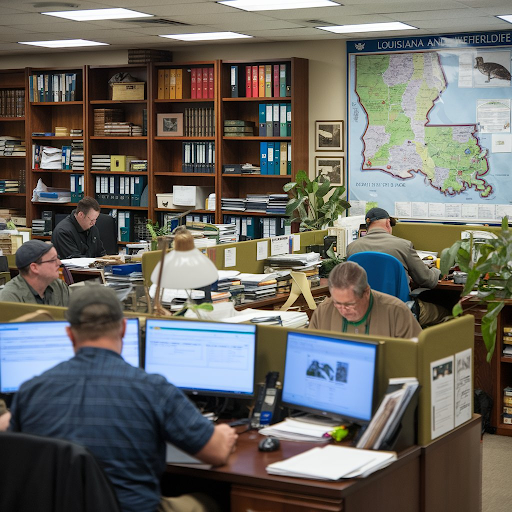Introduction
The Louisiana Department of Wildlife and Fisheries (LDWF) is a vital state agency responsible for managing, conserving, and promoting the wise utilization of Louisiana’s renewable fish and wildlife resources. With its diverse ecosystems, ranging from coastal wetlands to dense forests, Louisiana is home to a rich array of species that contribute significantly to the state’s natural beauty, economy, and cultural heritage. The LDWF plays a crucial role in ensuring the sustainability of these resources for future generations.
Contents
A History of Conservation
The LDWF’s history can be traced back to the early 20th century when Louisiana began to recognize the importance of conserving its natural resources. In the 1930s, the state established the Louisiana Conservation Commission, which was later reorganized into the Louisiana Department of Wildlife and Fisheries. Over the years, the LDWF has implemented numerous programs and initiatives to protect and manage Louisiana’s wildlife and fisheries.
Wildlife Conservation Efforts
The LDWF is committed to conserving Louisiana’s diverse wildlife populations. This includes efforts to protect endangered and threatened species, such as the Louisiana black bear, the bald eagle, and the American alligator. The department also works to maintain healthy populations of game species, including deer, turkey, waterfowl, and small game. The LDWF conducts research, implements habitat restoration projects, and enforces hunting and trapping regulations to achieve these goals.
One of the LDWF’s most significant wildlife conservation initiatives is its work to protect and restore Louisiana’s coastal wetlands. These wetlands are critical for various reasons, including providing habitat for numerous fish and wildlife species, protecting coastal communities from storms, and filtering pollutants from the water. The LDWF has implemented numerous projects to restore and maintain coastal wetlands, such as creating artificial reefs, planting marsh grasses, and constructing shoreline protection structures.
Fisheries Management
The LDWF also manages the Louisiana Department of Wildlife and Fisheries resources. These include freshwater and saltwater fisheries, which support a thriving commercial and recreational fishing industry. The department’s fisheries management efforts are focused on ensuring that fish populations are healthy and sustainable.
To achieve this goal, the LDWF researches to monitor fish populations and assess their health. The department also implements fishing pressure regulations, such as bag limits and size restrictions. The LDWF also protects fish habitat, including rivers, lakes, and coastal wetlands.
Boating Safety
The LDWF is also responsible for ensuring boating safety on Louisiana’s waterways. The department enforces boating laws and regulations, conducts safety inspections, and offers boating education courses. These efforts help to prevent accidents and protect boaters and the environment.
Public Outreach and Education
The LDWF is committed to educating the public about the importance of conserving Louisiana’s natural resources. The department offers a variety of educational programs, including school presentations, workshops, and public outreach events. These programs help raise awareness about the threats facing the Louisiana Department of Wildlife and Fisheries and the steps that can be taken to protect them.
Specific Conservation Initiatives
Coastal Restoration: The LDWF plays a pivotal role in restoring Louisiana’s eroding coastlines. Through projects like the Coastal Wetlands Restoration Program, they aim to create new wetlands, protect existing ones, and mitigate the impacts of sea-level rise. This is particularly crucial for safeguarding coastal communities and the unique ecosystems they support.
Endangered Species Recovery: The LDWF has implemented numerous programs to recover endangered and threatened species. For instance, they have worked to increase the population of the Louisiana black bear through habitat restoration and management efforts. They have also been instrumental in protecting the bald eagle’s nesting sites and ensuring the American alligator’s survival.
Habitat Management: The LDWF manages various habitats, including forests, wetlands, and prairies, to support diverse wildlife populations. This involves prescribed burns, thinning dense forests, and creating wildlife openings. These practices help to maintain healthy ecosystems and provide essential resources for wildlife.
Economic Impact
The LDWF plays a significant role in Louisiana’s economy. The state’s fishing and hunting industries generate billions annually, supporting jobs and contributing to local communities. The department’s efforts to conserve and manage natural resources help ensure these industries’ sustainability.
Challenges and Future Directions
The LDWF faces several challenges in its mission to protect and manage the Louisiana Department of Wildlife and Fisheries. These challenges include climate change, habitat loss, and pollution. The department must continue to adapt to these challenges and develop innovative solutions to ensure the long-term sustainability of Louisiana’s ecosystems.
In the future, the LDWF will likely focus on addressing the impacts of climate change, improving habitat connectivity, and enhancing public education and outreach. They will also continue to work closely with federal and state partners to achieve their conservation goals.
Coastal Restoration: The LDWF plays a pivotal role in restoring Louisiana’s eroding coastlines. Through projects like the Coastal Wetlands Restoration Program, they aim to create new wetlands, protect existing ones, and mitigate the impacts of sea-level rise. This is particularly crucial for safeguarding coastal communities and the unique ecosystems they support.
Conclusion
The Louisiana Department of Wildlife and Fisheries is a vital state agency that protects and manages Louisiana’s natural resources. Through its efforts to conserve wildlife, manage fisheries, ensure boating safety, and educate the public, the LDWF is helping to preserve Louisiana’s unique ecosystems and ensure that these resources are available for future generations.
